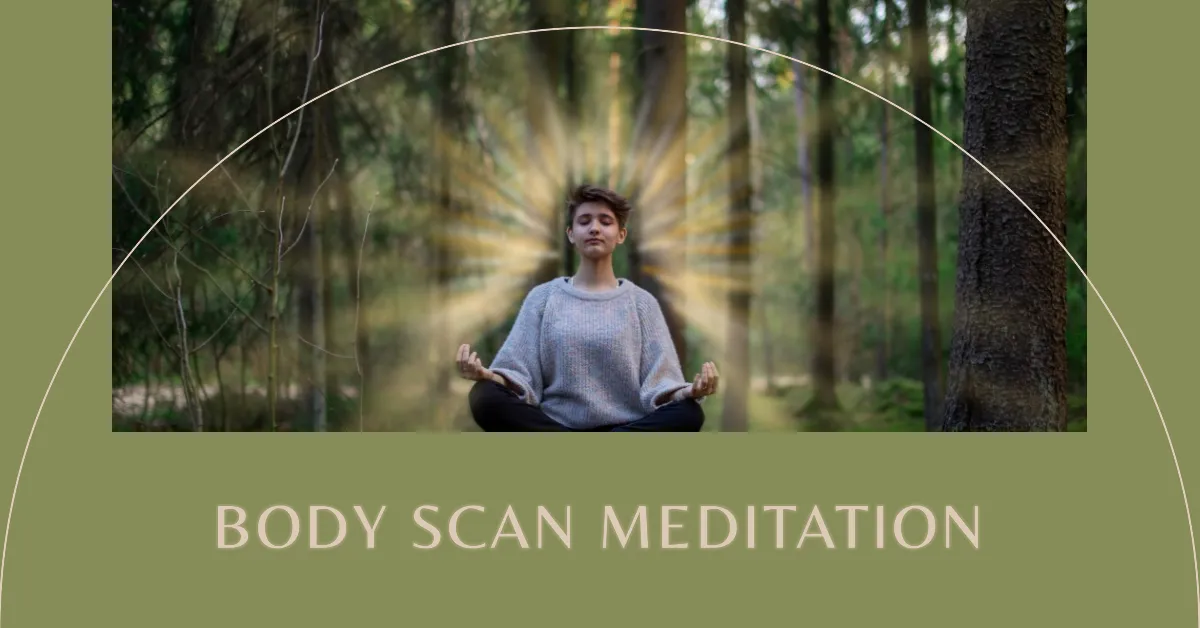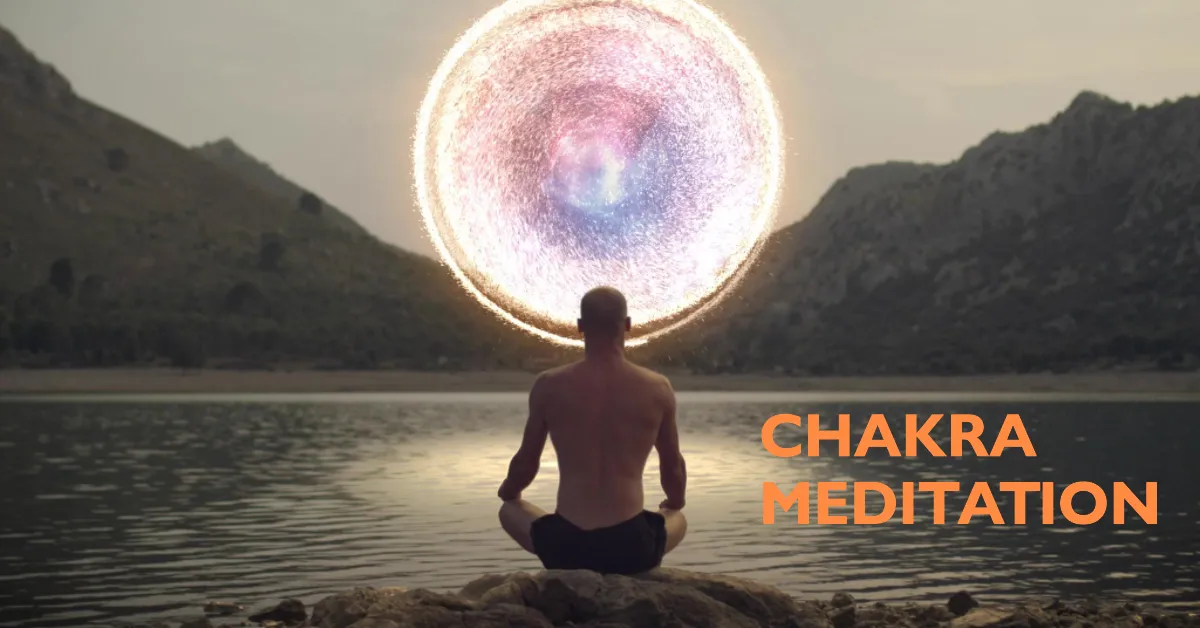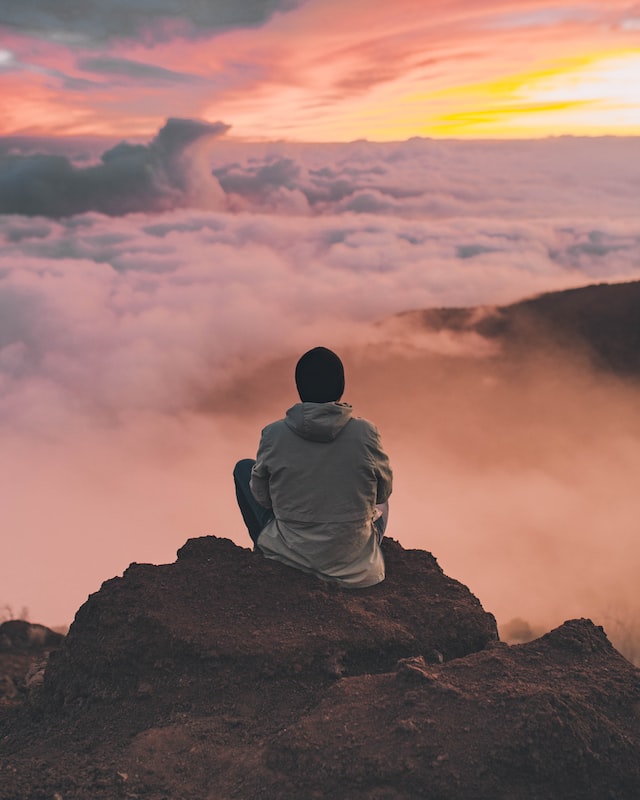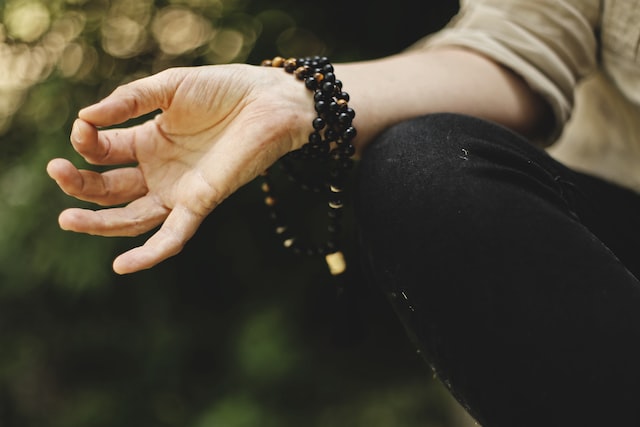If you’re new to meditation, it can be intimidating to know where to start. That’s why we’ve put together this guide on how to meditate. We’ll cover everything from finding a quiet space to settling into your breath and body. We’ll provide step-by-step instructions to help you build a simple and effective meditation practice. You’ll learn how to sit comfortably, focus your attention, and work with your thoughts and emotions.
So, grab a cushion or a chair and get ready to meditate! We’re excited to guide you on this journey toward greater peace, clarity, and well-being.
This article is a meditation guide for beginners. It touches upon the most common definitions and meditative practices known among the general public. Some terms are simplified for the reader’s sake. Meditation on its own has many practical uses and does not always call for internal focus nor it is practiced solely for the purpose of developing greater concentration, self-awareness, or inducing a state of relaxation. In fact, there are many meditative practices that require the practitioner to focus on the external focal points or meditation exercises that can induce a state of agitation (as opposed to relaxation) in the practitioner. This text, however, explains the fundamentals of meditation that are known and practiced by the general public.
Table of Contents
- 1 What Is Meditation?
- 2 How to Meditate
- 3
- 4 Meditation Tips
- 5
- 5.1 While You Meditate: Let Go
- 5.2 Go Into Your Meditation Practice without Expectations
- 5.3 Mindful Breath
- 5.4 Boosting Your Brain Power
- 5.5 Choose a Time to Meditate, and Stick To It
- 5.6 Mediate for Short Periods of Time at First
- 5.7 Create a Designated Space to Meditate
- 5.8 Wear Comfortable Clothing for Meditation Practice
- 5.9 Start with a Few Deep Breaths to Calm the Body and Relax the Muscles
- 5.10 Take a Couple of Moments to Calm Down and Clear Your Mind
- 6 Summary
What Is Meditation?

Meditation is (typically) a form of relaxation and contemplation that has been practiced for a very long time. In fact, everybody meditates in certain circumstances, they are just not aware of it. It can help you focus and connect with yourself, and can be used to manage stress and anxiety. There are many different types of meditation therefore, you should find a meditation practice that’s right for you. Some people choose to do seated meditation, while others prefer standing or walking meditation. You can also use mindfulness meditation to focus on your breathing and count your breaths.
In summary, meditation is the art of deep concentration that usually serves a defined purpose. There are many different types of meditation, so find one that will work best for you.
Meditation is also a part of the Power Performance system that is being used to help motivated professionals such as entrepreneurs, athletes, traders, intellectual workers, and other high-performance people awaken their true potential.
Meditation Benefits: What Does Meditation Do?
Meditation has been practiced for millennia for various reasons, including reducing stress, improving focus and concentration, and increasing self-awareness. It is thought that meditation can help you to develop a greater sense of well-being and inner peace. However, the benefits of meditation are not limited to people who practice it regularly. Anyone who wants to improve their mental health and quality of life can benefit from meditation. Meditation can also help you learn how to control your thoughts and emotions, which can be helpful if you have problems with anxiety or depression. The good thing about meditation is that as it trains your mind, once you learn it, it’s hard to forget. This means you can meditate seldom and still make significant improvements. Furthermore, meditation can help you learn how to be more mindful of your surroundings and how to connect with your body. The following are five ways that meditation can improve your mental health:
- Meditation practice can help you develop mental toughness and find your mental strength which increases self-confidence and willpower;
- Meditation can help with muscle relaxation, thus relieving physical stress from the body;
- Meditation can help you with the decision-making processes as daily meditation practice leads to a clear mind;
- Deep breathing will not only enable you to manage stress but also oxygenate your brain which helps you stay focused and pay attention to details;
- Mindfulness meditation will make you more aware of your surroundings;
- Meditation can support you in overcoming addictions.
As you can see, meditation can help you not only reduce stress levels and achieve inner peace or a calm mind. It can also increase your mental strength, teach you how to breathe deeply, how to improve focus, or pay attention to the environment around you. The list is not exhaustive as meditation practice includes many methods from really simple practices through mental conditioning to esoteric approaches. It’s up to you which path of meditation will you choose and what will you do with it.
How Do I Start Meditating?
Meditation is a simple and powerful way to calm your mind and improve your wellbeing. There are many different types of meditation, so it’s best to find one that works well for you. You can start by trying a few minutes of relaxation meditation or mindfulness meditation. After you get comfortable with that, you can try a more challenging form of meditation, such as candle gazing which involves staring at a candle flame without blinking, or body scan meditation. All you need is a place where nobody will disturb you and a bit of dedication as meditation practice requires patience.
In short, meditation is a great way to de-stress and find inner peace which doesn’t require any equipment.
What Happens While Meditating?
That is for you to find out. What is important is what you experience. Whether you meditate alone or in a group, whether you are wearing an esoteric robe or not, whether you are sitting in a church, on the top of a mountain, or in your own room, it doesn’t matter. What matters is that you experience peace and have a clear mind.
What are meditation benefits?
Meditation has many benefits; some of them are:
- Reduce stress, anxiety, and depression;
- Better and deeper sleep;
- Relieve pain and tension;
- Helps you create your own reality;
- Strengthen your immune system;
- Increase your self-awareness and self-esteem;
- Enhance your creativity;
- Improve your memory;
- Increase self-control and concentration;
- Reduces the effects of aging;
- Give you more energy and vitality;
- Expand your consciousness;
- Improve your relationships.
…but what’s the most important is your experience as where you are doing breathing exercises, walking meditation (a mindful walk), are using advanced deep meditation techniques, or just trying to reduce stress levels, meditation is merely a tool, while you are the craftsman.
What’s a Good Meditation for Beginners?
There is no one meditation practice that is right for everyone. The best meditation for you will depend on your own personal practice and preferences. However, some beginner-friendly meditations include mindfulness meditation, which helps you focus on your present moment and connect with your inner thoughts and feelings, and yoga meditation, which can help you relax your body and clear your mind.
If you’re new to meditation, it can be helpful to start with a practice that is gentle on your mind and body. One popular beginner meditation is the Vipassana meditation technique. This type of meditation is based on the Buddhist theory of insight meditation, which teaches that by observing our thoughts and feelings, we can learn to see the true nature of our minds.
To put it simply, this meditation technique focuses on observing what’s going on in your body and your mind. There are also guided meditations which are very suitable for beginners because you are listening to a previously recorded voice of someone else that’s telling you exactly what to focus on. You can start with guided meditations if you feel that other types are too demanding for the start.
How to Meditate
You can start meditating by focusing on the breath and body sensations. At first glance, this might seem easy but in reality, it is difficult to achieve. When I started, I have been able to meditate using this technique but I have not been able to do it consistently. It took me a couple of weeks of going through basic breathing exercises and get into the groove. Then, I understood the simplicity of the subject and everything suddenly have become easy.
The method is to focus entirely on the sensations of breathing and the sensations coming from the body. The idea is that you just observe the sensations without any judgment or thoughts. It should be easy to do, but in practice, it will take some time before you learn how to relax properly.
You start by sitting down and relaxing your body, then you try to focus on the sensations of breathing. Try to feel the breath within you and notice how it affects your organism. Focus your attention on what happens as the oxygen travels into the lungs and is transported to the bloodstream by the alveoli. If your mind wanders, you bring it back to the sensations. You do this with the goal of being able to last in this state without counting time. In the beginning, I have not been able to do it consistently because my mind used to wander too much. I am an over-thinker and my mind just wanders into all sorts of thoughts. If this also happens to you, just be aware that this is normal and you’re not the only one experiencing difficulty with meditation.
Go through the breathing meditation introduction first and when you feel ready, try the meditation techniques listed below. However, if this type of meditation feels too demanding for the start, try guided meditations instead. Remember, there are many meditation techniques but the goal of you will have a head start on the day. It’s a good feeling and it’s easier than you think. Try it and see. A beginner is simply to learn how to relax and achieve a clear mind, nothing more. Meditation for beginners should serve strictly this purpose. More advanced forms will come later.
Some Basic Meditations

Here are some basic forms of meditation for beginners. You can try them and let me know how you get on in the comment section. The methods are very informal. You can modify them to suit your style better. The general rule of thumb for most of the techniques is to lie down comfortably or sit in the half-lotus position if that’s your thing. Keep your eyes closed. Focus on your breathing and try not to think of anything else. It’s best to do this on an empty stomach, as it’s easier to focus. Breathe deeply and exhale slowly. Allow your body to relax. Spend a couple of minutes observing your thoughts and notice how the border of your physical body disappears. Simple practices, such as eyes closed, deep breathing, and muscle relaxation together just helped you achieve the state of trance. It will serve not just to reduce stress but mainly to allow you to enter a deeper state of gnosis later.
What to do next? Just focus on your breathing, but when thoughts pop into your head, replace them with an image of a boundless void. When your mind isn’t occupied with a thought, your breathing slows down. Pick a word that you don’t associate with any emotion, like ‘one’, ‘two’, or ‘three’. You’ll notice that your breathing slows down as you focus on the word.
Alternatively, after mastering all the techniques described in this guide, you can take a look at other meditation techniques aimed at more advanced practitioners.
Transcendental Meditation
To transced means “to be or go beyond the range or limits” or “to surpass”. Transcendental meditation is, therefore, a meditation that involves the act of transcendence – often relying on transcending the limitations of the ego by uniting with something bigger than yourself (e.g., the universe or god). Transcendental meditation has many practical purposes, such as transcending your fears to improve performance or transcending your false beliefs to open your mind to new knowledge. It is often closely related to ego transgression. Practicing transcendental meditation allows you to get beyond what you are now. It can be used for self-transformation or increasing knowledge and understanding.
P.S. Transcendental Meditation Technique (spelled with uppercase) is a trademarked and commercial variation of simple mantra meditation used to quiet down inner dialogue and rushing thoughts. It is not the same as the real transcendental meditation.
Trataka aka Candle Gazing Meditation
This is a bit different from the other methods. It involves a bit of preparation. First of all, you’ll need a candle. Now sit comfortably in a chair with your back straight and your eyes closed. Feel yourself relaxing as if you were just about to fall asleep (but remain conscious throughout the process). Allow yourself to be aware of your breath. Usually, it’s best to just follow the natural flow of breath. If your mind wanders, bring it back to the sensations of breathing. After doing this a couple of times, you’ll notice that your breathing has slowed down substantially.
Now focus on the candle flame and carry on looking at it without blinking. Be aware of the way the light dances within it. Don’t stare at it. Instead, let yourself gaze in a way that you’re not trying to see it. It’s not about staring, it’s about letting your mind be aware of the light without trying to see it. You’ll notice that after a period of time, the sight of the flame makes you tired. This means that you’ve relaxed enough to enter the trance state. Your subconscious is ready for a dialogue with the divine. You can also try a slightly different version of this method by focusing on the dark space surrounding the flame. In a way, it’s a bit easier because you don’t get tired so much.
In brief, focus on the flame, breathe deeply and try not to blink as long as you can. This exercise will relieve stress and build a deep state of focus. In the long term, it will improve your ability to stay still and concentrate on your work.
Walking Meditation aka Mindful Walk
The mindful walk meditation is a powerful tool to help us remain in the moment. In this practice, we keep our awareness on our steps, on the rhythm of breathing, and on the movement of the body. With each step we come back and touch the ground with our foot. We are not allowed to think about anything else but the present moment. Each step is a miracle, a cause-and-effect relationship. When we walk mindfully we can feel the contact of our feet with the earth while we maintain a space of calmness and peace. We can apply the same practice to sitting as well. Anytime during the day, when you are feeling stressed or anxious try to sit for 15 minutes and remain conscious of your body position or doing a quick walking meditation.
As a result, you will be less likely to feel overwhelmed or irritated. Take advantage of the time you have to calm your thoughts and get in a good mood. As you walk, you will start to feel calmer and more confident and as you feel more competent and in control of your work and life, you will be able to enjoy yourself more.
A study comparing the effects of brisk walking or meditation with a control group found that both meditation and brisk walking are suitable strategies to improve mood in young adults while another one revealed similar findings regarding stress reduction. It has also been proven that meditation training increases brain efficiency in attention tasks.
As you can see, walking meditation is a useful tool that can help you reduce stress, achieve a calm mind and sharper mindset. It also doesn’t require any tools. All you have to do to relieve stress is to go for a mindful walk and be aware of your steps.
Body Scan Meditation

A body scan meditation is a meditative exercise that involves focusing your attention on various parts of your body, which can help you to better understand how your body feels when you are experiencing different emotions. This exercise can also be used as a form of relaxation, or as a way of dealing with pain or physical discomfort.
Body Scan Meditation: Getting Started
Before you begin your body scan meditation, it’s a good idea to find a quiet place where you won’t be disturbed. Then, decide on the duration of your meditation. Most people find that a session of 20 to 30 minutes works well, although you may need to start out with only 5 minutes. The practice will involve relaxing your mind and paying attention to certain body parts. The experience is similar to a mindful walk, except you are not moving,
In short, to start your body scan meditation, find a quiet place where you won’t be disturbed. Choose the duration of your meditation- most people find 20 to 30 minutes works well.
Body Scan Meditation: Step-By-Step
- Choose a comfortable position. You can lie down on a couch or bed, sit in a chair, or even stand up if you’d like. Just make sure that you are able to hold this position for the duration of your meditation.
- Decide on a place to focus your attention. You can choose to focus on your breath, one of your senses, or a mantra, or you can simply watch your thoughts.
- Start breathing deeply. Focus on the sensation of your breath entering and leaving your nostrils. If your mind wanders, simply return your attention to your breath. Continue to gently focus on your breath for at least five minutes.
- Now, let your attention move to your thoughts. Let go of any resistance to the thoughts and let them be. Let them move by you. Observe them with curiosity, without judgment. And then, if a thought arises of its own accord, let that be noticed as well. It may be a memory, or a question, or something you feel like sharing. Just notice it and let it arise, then notice it and let it fall away. You don’t need to do anything but notice, and you can’t do anything wrong.
- As you sit here, let your awareness be everywhere in your body at once. Be aware of your breath in your nose, your belly rising and falling, and your heart beating. Be aware of the coolness of the air or the warmth of the sun on your skin. Be aware of the air moving through the room and the sounds of the birds outside (just the birds, not the cars or the people talking).
- Let your awareness flow into those sensations, let it ride on their waves, like the moon on the sea. Then, focus on a single sensation, coming from a single area of your body. This is it, you have just moved your attention to a specific body part.
- Now, begin slowly moving your awareness from the top of your head to the toes and the other way around. Notice any tension in your body as you’re doing so. If you spot overly tense body areas, use the breathing technique to aid you and breathe the air into this body part. Visualize the air flowing in on the inhale and flowing out on the exhale. As it flows out, see the tension escaping with the air. Repeat until the negativity completely leaves this body area and continue scanning in search of body tension.
What Is Chakra Meditation for Beginners?

Chakra meditation is a powerful way to tap into the power of your third eye, which can help you enhance your decision making abilities and spiritual growth. The practice of chakra meditation has been around for over 4,000 years and has been used to help people live a better life in alignment with their higher selves. It can help us access emotional, physical, and spiritual well-being.
The chakras are spinning energy centres inside your body. They each have a unique function, and when they are strong, balanced, and aligned we feel more empowered, more in control, and happier. The chakras each correspond to a part of the human body, as well as specific emotions and characteristics. When the chakras are out of balance or blocked, they can affect our health and well-being. The chakra system is like an energetic tree that is key to our overall health and well-being.
Chakra Meditation: What You Need to Know
In order to do a chakra meditation, you must know what a chakra is. A chakra is an energy center in your body. These energy centers can be found in the ancient Indian subcontinent, and they are also present in other cultures. They are believed to affect how people function, and how they feel.
There are seven main chakras in total. The seven chakras are said to be located in different parts of the body. It is believed that each chakra is responsible for a different thing. For example, the Root Chakra is located at the base of the spine. It is responsible for our survival instincts, as well as for our sense of security, safety, and stability. Furthermore, it is believed that the Root Chakra is also responsible for our physical and emotional health. Meditating with the root chakra will help you reduce stress levels and get a sense of security. Furthermore, using a breathing technique will deepen the experience. It is important to keep your eyes closed during such a meditation to be fully able to focus on the chakras.
Chakra Meditation: Step by Step
- Start with meditation: In order to do a chakra meditation, you must first meditate. You must get into a relaxed state of mind. This can take some time, so don’t get discouraged if you cannot reach this state right away. If it takes you a few tries, that’s alright. You will eventually get there with practice. Remember, meditation is a part of the mental conditioning process and patience is exactly what helps you condition your mind.
- Clear your mind of all thoughts: Before you can connect to the energy of your chakras, you must first clear your mind of all thoughts. This is easier said than done, but you must try. You are recommended to be silent or in a secluded place. Meditation can be done wherever you are but if you can find a quiet area where nobody will disturb you, the outcome will be better.
- Connecting to the root chakra: Once you have cleared your mind, you must now connect to your root chakra. Your root chakra is located at the base of your spine, and it is associated with the color red. Visualize a glowing red color at the base of your spine, and feel the energy flowing from it.
- Connecting to the sacral chakra: Now that you have connected to your root chakra, you must now connect to your sacral chakra. Your sacral chakra is located near your sexual organs and it is associated with the color orange. Visualize a glowing orange color in this area and feel the energy flowing from it. This is where sexual energy flows from, so if you feel any sexual tension during meditation, let it flow from this area.
- Connecting to the solar plexus chakra: Let’s connect to your solar plexus chakra. Your solar plexus chakra is located near your stomach and it is associated with the color yellow. This energy center is associated with your ego, self-confidence, and your personal power. Visualize a glowing yellow color in this area and feel the energy flowing from it.
- Connecting to the heart chakra: You shall now connect to your heart chakra. Your heart chakra is located near your heart and it is associated with the color green. The heart chakra corresponds to the feeling of unconditional love, acceptance, and freedom. Visualize a glowing green color in this area and feel the energy flowing around your heart.
- Connecting to the throat chakra: The next step is to connect to your throat chakra. Your throat chakra is located in the front of your neck and it is associated with the color blue. It is responsible for self-expression. Visualize a glowing light-blue color in this area and feel the energy flowing from it.
- Connecting to the third eye chakra: Also known as the third eye chakra. Connect to your third eye chakra by focusing your attention around your head area first. Your brow chakra is located in the center of your forehead and it is associated with the color indigo. It corresponds to your intellect and wisdom. Visualize a glowing indigo color in this area and feel the energy flowing from it.
- Connecting to the crown chakra: You must now connect to your crown chakra. Your crown chakra is located at the top of your head and it is associated with the color violet. Visualize a glowing violet color in this area and feel the energy flowing from it. If you do it correctly, you will feel tingling at the top of your head.
- Visualize a column of energy rising from your root chakra to your crown chakra: Once you have connected each chakra, visualize a column of energy rising from your root chakra to your crown chakra. This will help your body absorb the energy. As you visualize this, feel the energy flowing through your body. If you can, feel it entering your body through your root chakra and leaving your crown chakra. Feel this for a couple of minutes in order for your body to absorb the chakra energy.
- Connecting to your angels and guides: Now that you have connected to your chakras, connect to your angels and guides. Visualize an angel or guide that you know and feel their presence. Feel their love for you and their joy for you. Ask them to join you and feel their presence.
- Ask for healing: Now that you have connected to your angels and guides, ask them to heal you. Have them fill your body with their light and ask them to heal you of any physical and/or emotional ailments that you have. Your angels can take any form. Visualize the spirits or forces you believe in to ensure the meditation is coherent with your personal beliefs.
- Feel your body glowing: Now that you have asked for healing, feel your body glowing as it absorbs the healing energy. Feel your body becoming lighter and lighter as the healing energy fills it. Use a breathing technique to deepen the experience. Pay attention to the sensations within your body. When you notice tingling and other weird sensations all over your skin, it means the meditation is done. Relax and let it be for a couple of minutes, slowly open your eyes and get up.
Ready to Learn a Powerful Breath-Based Meditation Technique?
This is a mental conditioning exercise that enables you to energize your body. It’s not a relaxation exercise. It’s all about energy!
This is a breathing exercise also called “pranayama”. Pranayama means “breath control”. In this part, I’m going to teach you a mental conditioning technique. This exercise will improve your overall health and wellness. You’ll learn how to use your breath to remove negative emotions and even physical pain. I’ll also teach you a powerful visualization technique that will enable you to raise your energy levels effortlessly.
Every morning, right after you wake up, sit up in bed and close your eyes. Then take a powerful, deep breath and hold it for a couple of seconds. While you’re holding your breath, say the following phrase to yourself in your mind: “I am a powerful person. I am energizing my body.” Then blow out the air forcefully and sit quietly for a few seconds. Repeat this exercise a couple of times. Inhale deeply, hold your breath, and say the phrase, “I am energizing my body.” Then exhale as fast as you can.
By the way, for those of you who are wondering if this exercise really does anything, the answer is yes. Holding your breath deep in your lungs allows your alveoli to absorb more oxygen and pass it into the blood. With more oxygen circulating in your body, your brain and other vital organs will function more efficiently. If you do it every day, you will notice a huge difference in how energetic you feel.
What’s even more important than feeling energized is the fact that by doing this exercise, you are programming your subconscious mind to help you feel energetic. Here’s why: The subconscious mind controls your body. It controls everything, including your nervous system, your immune system, your breathing, and even your hormone production. So if you tell your subconscious mind that you are a powerful person, then it will make you feel energized. It can happen via many physiological pathways, for instance releasing hormones such as adrenaline and noradrenaline, or increasing glycogenolysis to prove you with more energy. The combination of physiological and psychological factors will do the job.
If you want to increase the efficacy even further, you can add a visualization technique. As you’re breathing in, visualize white light flowing in. The white energy travels along with the breath, to your lower abdomen, where the diaphragm is located. The energy gathers there and as you blow the air out, it explodes and travels up the spine, to the top of your head. Feel the white ray of exploding energy spreading through your body and energizing it. Adding this visualization technique will make the outcome of the exercise much more prominent.
Meditation Tips
Meditation is a way to focus and connect with your thoughts and feelings. There are many different types of meditation, and you can find one that works best for you. Some tips for meditation include setting a timer for five minutes and focusing on your breath, doing a guided meditation, or repeating a mantra. If you are having a hard time focusing, try doing ten long and slow breaths. If you still can’t focus, try listening to calming music. Some other things that you can do is go for a walk, color in a coloring book, or simply watch the clouds. You should also try to be present while doing something you enjoy, such as reading or writing.
A mindful walk is a great way to relieve stress and anxiety, and to set goals for yourself. It will also help your brain to function better and to form new connections. Walking meditation benefits are a calm mind, deep focus, and cardiovascular benefits provoked by physical exercise so you are killing two birds with one stone.
Meditation is a good way to relieve stress, but it’s also something that connects you with your thoughts and feelings. There are many different types of meditation, and you should find one that works best for you. Meditation is great for relieving stress and anxiety, and it will help your brain to function better and to form new connections.
Below, you can find some tips that can help you increase the efficacy of your meditation practice. Whether it’s advanced mental conditioning or a simple mindful walk, if you feel that what you’re doing is not giving you the outcome you expected, try the following tips and see for yourself how big of a difference they make.
While You Meditate: Let Go
Let go of the urge to analyze. If you’re focusing on your breath, try not to think about where the air is coming from and how it’s filling your lungs. Let your thoughts come and go. Don’t panic if you can’t control them. Observe your thoughts and let them flow. Take deep breaths. A good way to do this is to count the number of times you breathe in and out. Count to ten and start over again. When you breathe, fill your lungs as much as possible, and imagine that you’re breathing in positive energy. While you’re doing your meditation, try not to think about how long is left until the timer goes off. Don’t rush through it. Try to focus on just one thing. If you’re meditating on your breath, then don’t let your thoughts wander. Focus on your body. Feel your feet touching the ground or the floor. The same goes for the rest of your body. Feel your body and focus on the feeling itself. Don’t analyze, don’t think, and don’t be afraid. Experience the moment instead.
Go Into Your Meditation Practice without Expectations
If you’re doing it as a way of relaxing, don’t try to relax. Just meditate. If you’re doing it as a way of improving your focus, don’t try to improve your focus. Just meditate. If you go into your practice without expectations, you might be surprised by the results you get.
Mindful Breath
If you’re having a hard time focusing on your breath, try inhaling and exhaling deeply, while feeling the air coming out of your nose and filling your lungs. Try to feel your diaphragm pressing the air out of your body, and how your stomach gets sucked in when you breathe out. Do this for a while and then try to focus on your breath for another while. You might be surprised by how much easier it is to concentrate then.
Boosting Your Brain Power
If you’re doing a guided meditation, try to visualize the things that are being said to you. If you’re doing a simple meditation, try to visualize the things you’re thinking about. If you’re doing a guided meditation, try to visualize the things that are being said to you. It will help you improve your imagery power.
When you’re listening to an audio meditation and the person says “Relax your whole body”, relax every muscle in your body. When you’re listening to an audio meditation, and the person says “Imagine a beautiful, blue sky”, imagine a beautiful, blue sky. When you’re listening to an audio meditation, and the person says “Imagine a beautiful, green grass field”, imagine a beautiful, green grass field. This strategy will help you deepen the experience as by focusing on the instructions, you are letting go of the unwanted thoughts. Again, just experience the present moment and let it be.
Choose a Time to Meditate, and Stick To It
It can be as simple as 5 minutes in the morning or 15 minutes before you go to sleep, although bear in mind that your meditation practice will be the most effective if you meditate at the time of the day when you’re the most productive. Choose a time that works for you and stick to it. You may not be able to meditate for long at first, and that’s okay. The most important thing is to pick your time and stay by it. As with any new habit, into might be hard to stick with it in the beginning but as you get into the groove, it will become a formality.
Mediate for Short Periods of Time at First
Meditating for a long time can be a nuisance in the beginning therefore, I always recommend commencing to shorter time frames and gradually moving on as you gain more experience. Start easy and work up to longer periods. Keep a log of your progress. Prepare your mind before beginning your session and do not allow interruptions or distractions.
Furthermore, always be gentle with yourself. If you find that you cannot meditate for a particular length of time or find it difficult to stick to a regular routine, please do not hesitate to reach out for guidance or seek professional assistance (e.g. a mental conditioning coach).
As a result of healthy practice and consistent effort, you will be able to reap the many benefits that meditation can offer.
Create a Designated Space to Meditate
Meditation has been shown to have a plethora of benefits, both mental and physical. Whether you’re new to the practice or have been doing it for years, creating a designated space can help you focus and achieve your goals.
If you’re new to meditation, consider setting up a dedicated space in your home. You can create this space in a corner of your bedroom, living room, or even your bathroom. The key is to make it your own so you can relax and focus as much as possible. Think about what inspires you and incorporate it into your space. A peaceful painting, a candle, a Buddha statue, etc. Whatever makes you feel good and relaxed, bring those elements into your space. What’s more, you can also use your space to practice mindfulness. Mindfulness is a practice that helps you focus on the present moment and aim to be in the present. When you meditate, you’re training your mind to become more aware of your surroundings. This can help you live in the moment and focus on what’s important.
In summary, setting up a dedicated space for meditation can help you focus and achieve your goals. When you find a space that works for you, make sure to bring your mindfulness practice so you can be present in your own, dedicated meditation space to achieve the right mindset and increase the effectiveness of your practice.
Wear Comfortable Clothing for Meditation Practice
When you begin practicing meditation, it’s important to be comfortable. Make sure to wear clothing that allows you to move freely and breathe easily. Some people choose to meditate in a comfortable seated position with their eyes closed. Others prefer to sit on the ground with their legs crossed and focus on their breath. Whatever position you choose, it’s important to be comfortable therefore, make sure your clothes allow you to move and breathe easily.
In addition, it’s helpful to keep a meditation journal or some other writing instrument nearby so you can capture your thoughts and experiences during your practice. You can use the journal to note down which clothes make you feel the most comfortable to distinguish the clothing that allows you for the most productive sessions from the clothes that are not as comfortable.
Start with a Few Deep Breaths to Calm the Body and Relax the Muscles
Breathe in and out through your nostrils. Feel your spine straighten and your shoulders relax. Feel the warmth in your belly. Now start at the toes and work up to your face, one part at a time. Start with the toes and work up to the face. Focus on the toes as you breathe in slowly. Keep the focus on the toes as you exhale slowly.
Relax every inch of your toes. Relax every inch of your feet. Move on to relaxing your ankles. Continue with your legs. Now, focus on the hips. Slowly move to your torso and all the surrounding muscles. Then, relax every inch of your arms and let this feeling of relaxation spread to your hands and fingers. Come back up and move your awareness toward your neck. Let go of the tension in your jaw, mouth, and around your head.
Repeat this process every time you’re struggling to calm down. It will help you relax and enter the trance state.
Take a Couple of Moments to Calm Down and Clear Your Mind
Slow down and be present in the moment. Relax your mind and let go of stressful thoughts. Allow yourself to be free. Give yourself a break. Don’t take your practice too seriously. Remember that everything is going to be alright even if you can’t seem to find the right pace in the first place. Sacrifice a couple of minutes to laugh off today’s problems. Be silly and light-hearted. Let go of your inner dialogue and remember to breathe.
When you’re feeling overwhelmed or stressed, it’s easy to make poor decisions. The same applies to meditation. Take a few moments to calm down and clear your mind before you start meditating to prevent stress from ruining your session. This will make your practice more productive.
Summary

Meditation is a simple yet powerful practice that can bring a multitude of benefits to your physical and mental health. The best part is that you don’t need any special equipment or training to get started. You can begin practicing in the comfort of your own home and learn from books or online resources. However, if you want to deepen your practice or have specific questions, working with a coach or teacher can also be helpful. The key is to approach meditation with an open mind and a willingness to learn. With consistent practice, you can cultivate greater peace, focus, and well-being in your life.
Meditation is a tool that can help you reduce stress and body tension, improve cognitive functioning and attention span, or simply allow you to enjoy your life, among many other benefits. In conclusion, meditation can be a great way to improve your life in many ways. If you want to learn how to meditate from scratch, get my 8-week meditation guide – why not give it a try today and see for yourself the positive impact it can have on your life?






